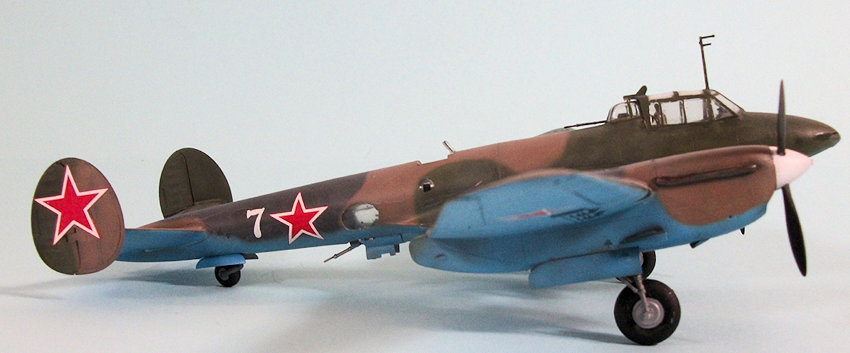
Zvezda 1/48 Pe-2
| KIT #: | 4809 |
| PRICE: | $44.95 SRP |
| DECALS: | Three options |
| REVIEWER: | Tom Cleaver |
| NOTES: |

| HISTORY |
Known to its crews as the “Peshka” (pawn), the Petlyakov Pe 2 was considered one of the best ground attack aircraft of the war and it was extremely successful in the roles of heavy fighter, reconnaissance and night fighter. It was called “The Soviet Mosquito” for its speed and multi-role adaptability. One of the most important multi-engine aircraft of the war, it was third behind the Ju-88 and Wellington in production numbers, with 11,427 built. The Pe 2 was fast, maneuverable and durable, and was used by several Eastern European Warsaw Pact nations and Communist China after the war, known by the NATO reporting name “Buck” before being phased out of service in 1955.
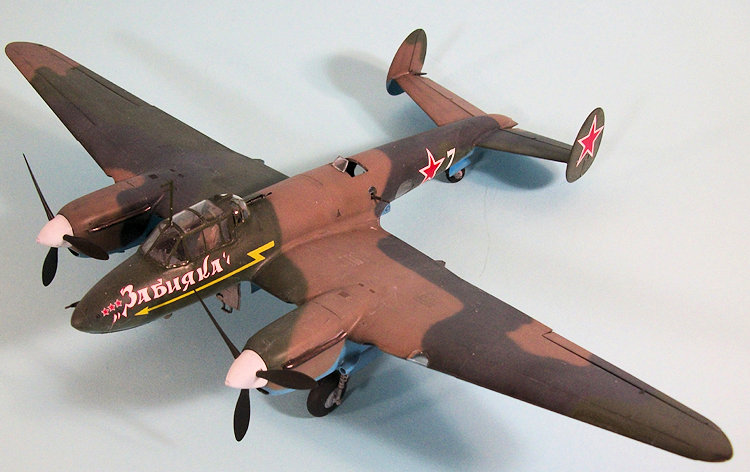 Designer Vladimir
Petlyakov was been arrested and imprisoned in 1937 on a charge of “sabotage” for
allegedly deliberately delaying design work on the Tupolev ANT 42 bomber (later
known as the Pe-8). Working in a prison design bureau (sharashka), Petlyakov was
placed in charge of a team ordered to develop a high altitude fighter escort for
the ANT 42 under the designation VI 100. The first of two prototypes flew on
December 22, 1939; it was a very sophisticated aircraft for its time, featuring
pressurization, all metal construction, superchargers and many
electrically actuated systems. The prototypes were so successful that production
was ordered almost immediately. Petlyakov and his team could see the VI 100
prototype as it was put through its paces for the crowds watching the annual May
Day parade in 1940 from their prison.
Designer Vladimir
Petlyakov was been arrested and imprisoned in 1937 on a charge of “sabotage” for
allegedly deliberately delaying design work on the Tupolev ANT 42 bomber (later
known as the Pe-8). Working in a prison design bureau (sharashka), Petlyakov was
placed in charge of a team ordered to develop a high altitude fighter escort for
the ANT 42 under the designation VI 100. The first of two prototypes flew on
December 22, 1939; it was a very sophisticated aircraft for its time, featuring
pressurization, all metal construction, superchargers and many
electrically actuated systems. The prototypes were so successful that production
was ordered almost immediately. Petlyakov and his team could see the VI 100
prototype as it was put through its paces for the crowds watching the annual May
Day parade in 1940 from their prison.
Just as production was about to begin, the air force ordered a re design. The Luftwaffe had just demonstrated the value of tactical bombing in the 1940 Blitzkrieg, and the need for an aircraft similar to the Ju-88 suddenly became much more important than the need for a high altitude escort fighter. Petlyakov's team was given 45 days to redesign their aircraft as a dive bomber. Pressurization and superchargers were deleted, while dive brakes a bomb bay and a bombardier position were added. The resulting aircraft was initially designated PB 100, but Josef Stalin was impressed enough with Petlyakov’s work to free him, and his name was used in the aircraft's designation. The first aircraft flew on December 15, 1940, having been rushed through production without a prototype under severe threats from Stalin if a Pe 2 did not fly by the end of the year. Deliveries to combat units began the following Spring.
The Pe 2 quickly
proved itself to be a highly capable aircraft following the German invasion,
able to elude the Luftwaffe's interceptors. On 1 July 1941, six Pe 2s fought off
attacks by four Bf 109Fs, shooting down two. A week later a group of Pe 2s was
attacked by four Bf 109Fs and again brought down two of the attackers. On both
occasions the bombers suffered no losses. On the southern front, a bombing
mission against Ploesti by six Pe 2s, led by Capt. A. Tsurtsulin, resulted in
the destruction of 552,150 gallons of petroleum. The Romanians claimed that at
least 100 Soviet aircraft had participated in the attack. A German pilot shot
down by a Pe-2 stated the Pe 2 “... is a fast aircraft, with good armament, and
it is dangerous to enemy fighters." Pe 2 crews complained about insufficient
defensive armament and
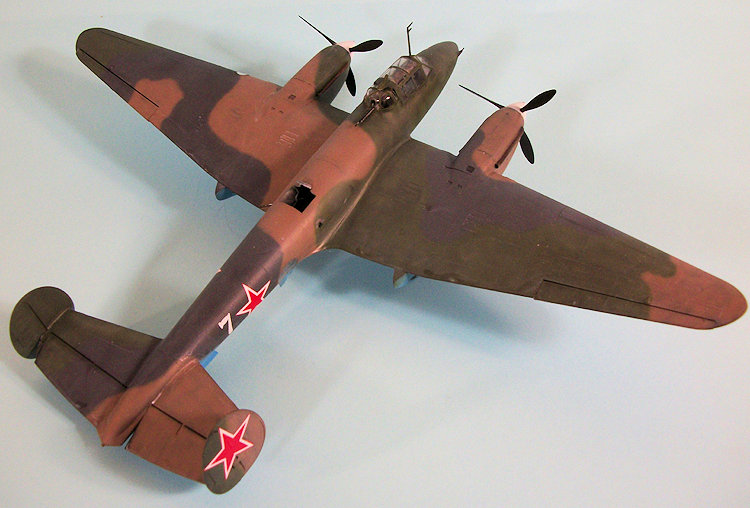 survivability, due to insufficient armor and fire risk,
especially for the navigators and gunners as German pilots soon discovered the
limited sighting angles of the ventral gun mount. On average, ten Pe 2 gunners
were wounded for every pilot, and two or three were killed for the loss of one
pilot. The design was steadily refined and improved throughout 1942, in direct
consultation with pilots who were actually flying them in combat. Improved armor
protection and a fifth ShKAS machine gun were installed and the fuel tanks were
protected.
survivability, due to insufficient armor and fire risk,
especially for the navigators and gunners as German pilots soon discovered the
limited sighting angles of the ventral gun mount. On average, ten Pe 2 gunners
were wounded for every pilot, and two or three were killed for the loss of one
pilot. The design was steadily refined and improved throughout 1942, in direct
consultation with pilots who were actually flying them in combat. Improved armor
protection and a fifth ShKAS machine gun were installed and the fuel tanks were
protected.
The resulting sub-type has been called the Pe 2FT for production series after 83 (FT stands for Frontovoe Trebovanie - Frontline Request), although no official Soviet documents use this identification.
| THE KIT |
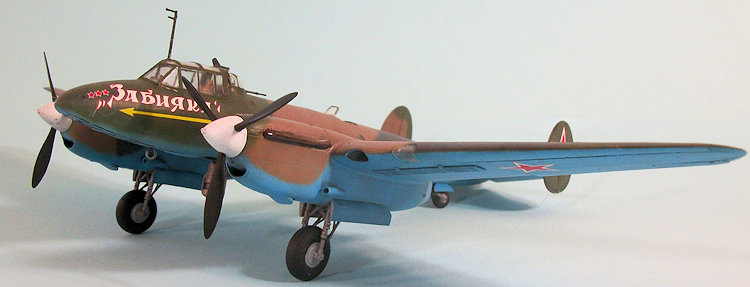 The Pe-2 is my
favorite Soviet aircraft of the Great Patriotic War, and I am really glad to see
this important aicraft finally given proper treatment by Zvezda. Airfix was the
first to attempt the Pe-2 with a 1/72 kit issued in the 1960s which was the only
alternative for some 40 years. Both MPM and HiPM issued 1/48 kits in the late
1990s/early 2000s. Both were difficult kits and indifferent models when
completed.
The Pe-2 is my
favorite Soviet aircraft of the Great Patriotic War, and I am really glad to see
this important aicraft finally given proper treatment by Zvezda. Airfix was the
first to attempt the Pe-2 with a 1/72 kit issued in the 1960s which was the only
alternative for some 40 years. Both MPM and HiPM issued 1/48 kits in the late
1990s/early 2000s. Both were difficult kits and indifferent models when
completed.
Zvezda’s kit is everything every other Pe-2 kit has not been. It is overall accurate, with great detail inside and out. It has what I think is the best surface detail of any kit ever: the panel lines and rivet detail are so petite you have to hold the model up to the light to see it. The kit provides decals for three aircraft.
| CONSTRUCTION |
Overall, this kit is complex but not complicated. A modeler who follows the instructions will not run into trouble, and a great model will result. I used Tamiya Light Grey (XF-66) for the interior color.
I found that when I used the enclosed cowlings, it is impossible to see even the rear engine detail that is provided, through the open wheel wells. If you just use the backing plate and paint it dark grey, all will be well. Modelers who want more detail have the option of doing one very nicely detailed engine to display “opened up.”
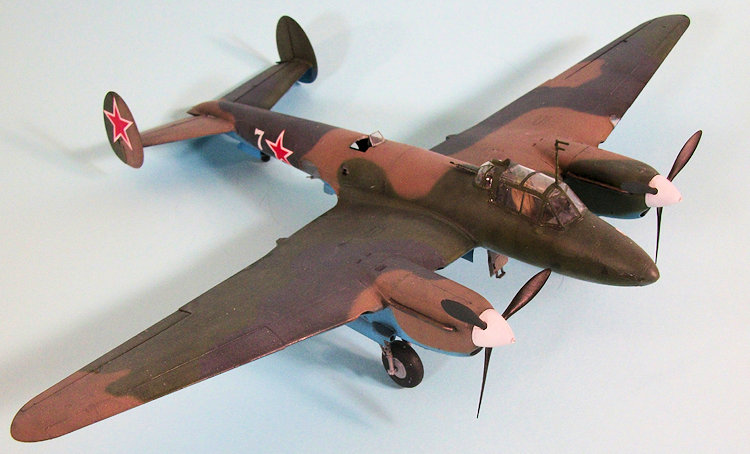 Take care with
assembly and part fit is so precise you will not need to fill seams. When you
assemble the interior bulkheads, scrape them down a bit. Fitting the fuselage
halves together is very tight, and doing this will allow the center section of
the fuselage to go together so well there will be no need of any sort of seam
filler anywhere.
Take care with
assembly and part fit is so precise you will not need to fill seams. When you
assemble the interior bulkheads, scrape them down a bit. Fitting the fuselage
halves together is very tight, and doing this will allow the center section of
the fuselage to go together so well there will be no need of any sort of seam
filler anywhere.
Take your time doing all the interior detailing of the cockpit and gunner’s compartments. If you open up the hatches, there will be enough light inside to see the work.
It may seem counterintuitive to assemble the main gear early on, before assembling the engine nacelles, but this does make things easier, and it is easy to wrap the assembled gear with drafting tape for protection during the rest of the assembly process.
The one bit of poor fit involves the clear parts for the bombardier’s glass in the lower nose and the cockpit canopy. You will have to sand around the edge of the lower clear part to get it the proper dimensions. If you rubber band the cockpit canopy in position while the glue sets up, it should not leave any gaps.
| COLORS & MARKINGS |
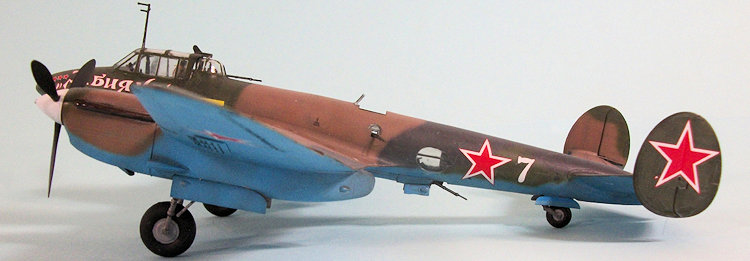 I used Tamiya German Grey (XF-68), NATO Green (XF-67) and Flat Earth
(XF-52)for the upper colors and Tamiya Sky Blue (X-14) with 10% Flat White for
the lower color. Like most Soviet Aircraft, there were several possible
camouflage patterns depending on the factory the airplane came from, and Zvezda
provides good painting diagrams for each of their three options (two of which
are closely similar).
I used Tamiya German Grey (XF-68), NATO Green (XF-67) and Flat Earth
(XF-52)for the upper colors and Tamiya Sky Blue (X-14) with 10% Flat White for
the lower color. Like most Soviet Aircraft, there were several possible
camouflage patterns depending on the factory the airplane came from, and Zvezda
provides good painting diagrams for each of their three options (two of which
are closely similar).
The Zvezda decals are good. They come off the backing sheet quickly. I found I needed to use Solvaset to get them to settle into the petite surface detail.
| CONCLUSIONS |
This kit is Zvezda’s best to date. The kit is moderately difficult, but if you take your time all is well. The result is a really beautiful World War II twin, worthy of being a part of any collection of Soviet aircraft of the Great Patriotic War. Highly recommended.
February 2016
Copyright ModelingMadness.com
Review kit thanks to
my friend Kevin Thompson.
If you would like your product reviewed fairly and
fairly quickly, please
contact
the editor
or see other details in the
Note to
Contributors.